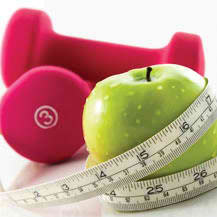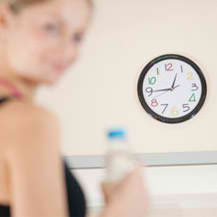Headlines warn us about hazardous chemicals in ordinary products. How much do we have to worry?
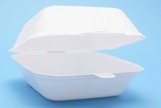
1. "Clamshell" takeout food containers
Or any food packaging labeled #6 in the recycling symbol*
What It Contains
Polystyrene (Styrofoam).
Concerns
May leach styrene (a possible endocrine disrupter and human carcinogen) into food, and into groundwater from landfills.
What You Should Do
Avoid food that has come into contact with polystyrene.
*usually located on the bottom of the container
Or any food packaging labeled #6 in the recycling symbol*
What It Contains
Polystyrene (Styrofoam).
Concerns
May leach styrene (a possible endocrine disrupter and human carcinogen) into food, and into groundwater from landfills.
What You Should Do
Avoid food that has come into contact with polystyrene.
*usually located on the bottom of the container
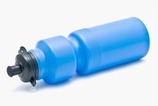
2. Reusable "sport" water bottles
Look for plastics labeled #7 in the recycling symbol. Also check metal-lined containers (such as those used for some baby formulas and cocoa powder), five-gallon water bottles, and most plastic baby bottles
What They Contain
Polycarbonate, which may contain bisphenol A.
Concerns
Bisphenol A is a suspected hormone disrupter and has been found to stimulate prostate cancer cells.
What You Should Do
Replace plastic baby bottles with glass, and water bottles with stainless steel or those made of high-density polyethylene — labeled #2 in the recycling symbol. Avoid putting plastics into the microwave or dishwasher. To be extra careful, use ceramic or glass containers instead.
Plastics labeled #1, #2, #4 and #5 are safer than those labeled #3, #6 and #7.
Look for plastics labeled #7 in the recycling symbol. Also check metal-lined containers (such as those used for some baby formulas and cocoa powder), five-gallon water bottles, and most plastic baby bottles
What They Contain
Polycarbonate, which may contain bisphenol A.
Concerns
Bisphenol A is a suspected hormone disrupter and has been found to stimulate prostate cancer cells.
What You Should Do
Replace plastic baby bottles with glass, and water bottles with stainless steel or those made of high-density polyethylene — labeled #2 in the recycling symbol. Avoid putting plastics into the microwave or dishwasher. To be extra careful, use ceramic or glass containers instead.
Plastics labeled #1, #2, #4 and #5 are safer than those labeled #3, #6 and #7.
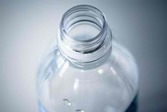
3. Water and soft-drink bottles when refilled
Look for plastics labeled #1 in the recycling symbol
(typically)
What They Contain
Polyethylene terephthalate.
Concerns
The bottles are considered safe but are intended for single use only; they should not be reused because they may have picked up bacteria from the first use.
What You Should Do
Use only once (and then, of course, recycle!). Even if you wash them, you cannot be sure they have been properly sanitized.
Look for plastics labeled #1 in the recycling symbol
(typically)
What They Contain
Polyethylene terephthalate.
Concerns
The bottles are considered safe but are intended for single use only; they should not be reused because they may have picked up bacteria from the first use.
What You Should Do
Use only once (and then, of course, recycle!). Even if you wash them, you cannot be sure they have been properly sanitized.
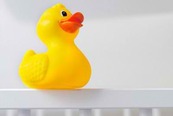
4. Backyard furniture, shower curtains, toys
Look for plastics labeled #3 in the recycling symbol
What They Contain
Polyvinyl chloride (PVC), which often contains softeners called phthalates.
Concerns
PVC releases toxic chemicals during its manufacture. Phthalates, for their part, can damage the liver, kidneys and reproductive systems of animals. Suspected endocrine disrupters, they mimic hormones and may interfere with children's growth and development, especially if infants chew or suck on vinyl products.
What You Should Do
Avoid PVC products and soft plastic toys, which young children may put in their mouth. Look for plastics labeled #1, #2, #4 or #5, which are not endocrine disrupters.
Look for plastics labeled #3 in the recycling symbol
What They Contain
Polyvinyl chloride (PVC), which often contains softeners called phthalates.
Concerns
PVC releases toxic chemicals during its manufacture. Phthalates, for their part, can damage the liver, kidneys and reproductive systems of animals. Suspected endocrine disrupters, they mimic hormones and may interfere with children's growth and development, especially if infants chew or suck on vinyl products.
What You Should Do
Avoid PVC products and soft plastic toys, which young children may put in their mouth. Look for plastics labeled #1, #2, #4 or #5, which are not endocrine disrupters.
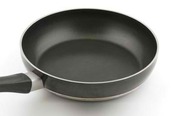
5. Non-stick cookware (when overheated)
Perfluorinated chemicals (PFC). (Some new non-stick cookware does not contain PFC.)
Concerns
Non-stick pans may give off fumes containing TFE, a suspected carcinogen, when they get hotter than 650°F. How hot is that? Olive oil, for example, starts smoking at 410°F, well below that level.
What You Should Do
Just to be safe, don't allow empty pans to smolder on a hot burner.
Perfluorinated chemicals (PFC). (Some new non-stick cookware does not contain PFC.)
Concerns
Non-stick pans may give off fumes containing TFE, a suspected carcinogen, when they get hotter than 650°F. How hot is that? Olive oil, for example, starts smoking at 410°F, well below that level.
What You Should Do
Just to be safe, don't allow empty pans to smolder on a hot burner.
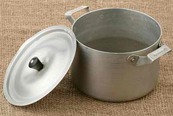
6. Worn and pitted pots and pans
What They May Contain
Aluminum.
Concerns
Aluminum has been associated with Alzheimer's disease. However, no definite link has been proven.
What You Should Do
Consider getting rid of older pots and pans, which leach the most aluminum into your food. Leafy vegetables and acidic foods, such as tomatoes, absorb the most. Anodized aluminum pots, with a hard non-stick surface, are a better choice.
Sorcue: rdasia.com
What They May Contain
Aluminum.
Concerns
Aluminum has been associated with Alzheimer's disease. However, no definite link has been proven.
What You Should Do
Consider getting rid of older pots and pans, which leach the most aluminum into your food. Leafy vegetables and acidic foods, such as tomatoes, absorb the most. Anodized aluminum pots, with a hard non-stick surface, are a better choice.
Sorcue: rdasia.com
